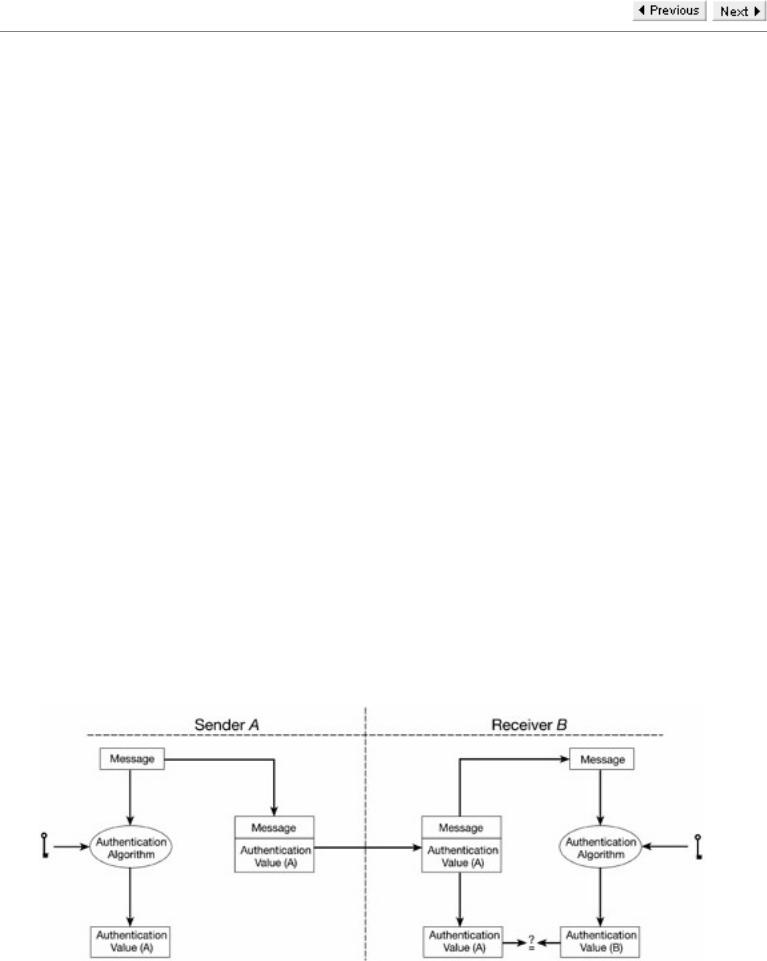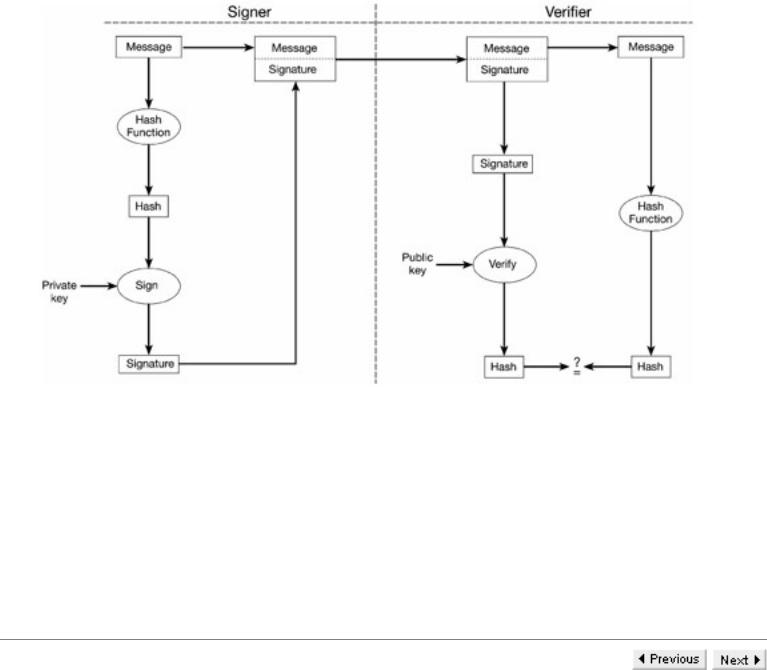
- •Table of Contents
- •BackCover
- •Cryptography-A Very Short Introduction
- •Chapter 1: Introduction
- •Using this book
- •Chapter 2: Understanding Cryptography
- •The basic concepts
- •Chapter 3: Historical Algorithms: Simple Examples
- •Caesar Cipher
- •Simple Substitution Ciphers
- •The statistics of the English language
- •The Playfair Cipher
- •Homophonic Coding
- •Polyalphabetic Ciphers
- •Vigenère Ciphers
- •Transposition Ciphers
- •Super-encryption
- •Some conclusions
- •Appendix
- •Chapter 4: Unbreakable Ciphers?
- •Perfect secrecy
- •The one-time pad
- •Chapter 5: Modern Algorithms
- •Bit-strings
- •Stream ciphers
- •Block ciphers (ECB mode)
- •Hash functions
- •Public key systems
- •Chapter 6: Practical Security
- •Realistic security
- •Practical exhaustive key searches
- •Attacks on public key systems
- •Chapter 7: Uses of Cryptography
- •Using symmetric algorithms for confidentiality
- •Authentication
- •Using symmetric algorithms for authentication and data integrity
- •Digital signatures
- •Certification authorities
- •Public Key Infrastructure
- •The need for trust
- •Chapter 8: Key Management
- •The key life cycle
- •Key hierarchies
- •Managing keys in networks
- •Using a trusted management centre
- •Key recovery and key back-up
- •Chapter 9: Cryptography in Everyday Life
- •A cash withdrawal from an ATM
- •Pretty Good Privacy (PGP)
- •Secure web browsing
- •Using a GSM mobile phone
- •References and further reading

Authentication
Team-Fly
Authentication
The word authentication has two distinct meanings in the context of information security. One meaning relates to data origin authentication, which is concerned with verifying the origin of received data, while the other meaning relates to (peer) entity authentication, where one entity verifies the identity of another.
Data origin authentication is, typically, accompanied by a process of confirming the integrity of the data. Entity authentication takes many forms, but when based on cryptography, tends to rely on an exchange of messages between the pair of entities. This exchange is called an authentication protocol. Throughout this book we have frequently referred to users and regarded them as people. However in this context an entity is likely to be either a computer or a human user.
User authentication is, of course, fundamental to the concept of access control, and there are a number of ways for users to authenticate themselves, either to each other or to computer networks. The basic techniques tend to depend on at least one of the three following properties:
●something known: this might, for example, be a password or a PIN that the user keeps secret;
●something owned: examples include plastic cards or hand-held personalized calculators;
●some characteristic of the user: these include biometrics, such as fingerprints and retina scans, hand-written signatures or voice recognition.
Probably the most common methods involve combinations of something known or something owned. There is, of course, always the danger that anything known may be discovered by an adversary and that they might steal, or copy, anything that is owned. This lends support to the claim that the only methods that can genuinely authenticate users should depend on one of their characteristics, such as a biometric.
However, for a number of practical reasons, biometrics are not yet widely implemented.
Team-Fly
file:///D|/1/4303/Fly0033.html [08.10.2007 12:51:18]

Using symmetric algorithms for authentication and data integrity
Team-Fly
Using symmetric algorithms for authentication and data integrity
Authentication and data integrity can both be achieved using symmetric cryptography. We consider first authentication and then data integrity. There are two types of authentication. In one-way authentication, one user is authenticated to another user; whereas in twoway authentication, both users are authenticated to each other. Chapter 9 discusses the use of a magnetic stripe card at an ATM (cash
machine), which is an example of one-way authentication. The card is cryptographically authenticated to the ATM by using a PIN. However, the cardholder has to use non-cryptographic means such as the location and design of the ATM to be convinced that the ATM is genuine. Logging onto a computer is usually another example of one-way authentication. Either type of authentication involves the use of an agreed algorithm and secret information or key. The correct use of this key in the algorithm provides the authentication. Clearly, this process relies on the key not being compromised. Furthermore, advanced authentication techniques often require the use of an agreed protocol involving the exchange of challenges and responses (which are encrypted versions of the challenge).
It must be noted that use of an authentication protocol only establishes the identities of the parties at the instant that the protocol took place. If either confidentiality or data integrity is required for information during the life of the connection that has just been authenticated, then other cryptographic mechanisms are needed to provide that protection. The keys needed for these cryptographic processes may be exchanged as part of the authentication protocol. However, if protection is needed against the replay of (part of) the authentication protocol by an impostor, then extra information, such as sequence numbers or time stamps, also have to be included.
Data integrity for a message can be assured using an authentication algorithm and a secret key. The authentication algorithm accepts the message and the agreed key as input and then calculates an authentication value which is the output. This authentication value is nothing more than a (short) bit-string whose value depends on the authentication algorithm, the message and the agreed key. In the terminology of Chapter 5, the authentication algorithm is a keyed hash function.
When user A wishes to send a message to user B, he appends the authentication value to the message. B receives the message and its authentication value. B then calculates the output of the authentication algorithm with the message received from A and the agreed secret key as input. If this output agrees with the authentication value sent by A, then B can be confident that the message came from A and has not been altered. (Thus the authentication function provides both data integrity and authenticates A.) The observant reader will have noticed that the use of this type of authenticator does not prevent replays. In order to protect against this type of attack, as we have already noted, users need to append identifiers, such as sequence numbers, to the messages.
One important aspect of this authentication process is that the sender and receiver perform exactly the same calculations. Thus, if there were ever a dispute between A and B as to what was sent, there would be no cryptographic way of settling it. This is not really a fault of the system, but merely a consequence of using symmetric cryptography. Here A and B must trust each other. They share a secret key and are relying on the secrecy of that key to protect them against alteration attacks from any third party. They are not seeking protection from each other because they have this mutual trust. In general this is true of most users of symmetric cryptography. It is used by mutually trusting parties to protect their information from the rest of the world.
Authentication with symmetric authentication
file:///D|/1/4303/Fly0034.html (1 von 2) [08.10.2007 12:51:18]

Using symmetric algorithms for authentication and data integrity
The most widely used authenticator, particularly by the financial sector, is called a Message Authentication Code (MAC). If the message is M1, M2,..., Mn, where each Mi consists of 64 bits, then DES in CBC mode is used. However, the only ciphertext block that is
required is Cn. The MAC then consists of 32 bits of Cn.
Team-Fly
file:///D|/1/4303/Fly0034.html (2 von 2) [08.10.2007 12:51:18]

Digital signatures
Team-Fly
Digital signatures
For the reasons explained in Chapter 5, the use of asymmetric algorithms tends to be restricted to the protection of symmetric keys and to
the provision of digital signatures. If there is a requirement for settling disputes between sender and receiver as to the contents of a message or of its origin, then the use of symmetric cryptography does not provide the answer. Digital signatures are required.
The digital signature for a message from a particular sender is a cryptographic value that depends on the message and the sender. In contrast, a hand-written signature depends only on the sender and is the same for all messages. A digital signature provides data integrity and proof of origin (non-repudiation). It can be kept by the receiver to settle disputes if the sender were to deny the content of the message or even to deny having sent it. It is the provision of a means of settling disputes between sender and receiver that distinguishes the digital signature mechanism from the MACing process described in the last section. Clearly such disputes can only be settled if there is asymmetry between sender and receiver. This observation suggests asymmetric cryptosystems as the natural tools for providing digital signatures.
For a digital signature scheme based on a public key system such as RSA or El Gamal, the basic principle is very simple. Each user has a private key that only they can use, and its use is accepted as identifying them. However, there is a corresponding public key. Anyone who knows this public key can check that the corresponding private key has been used, but cannot determine the private key.
Accepting that the private key must have been used gives the receiver assurance of both the origin and content of the message. However, the sender is reassured that impersonation is impossible as the private or signature key cannot be deduced from the public or verification key or the digital signature.
Asymmetric cryptographic processing requires much computational processing. Thus a condensed version or hash of the message is produced by applying a hash function to the message. The signature is produced from the hash (which represents the message) by using the asymmetric algorithm with the private key. Thus only the owner of the private key can generate the signature. The signature can be verified by anyone who knows the corresponding public key. To do this a value is produced from the signature using the asymmetric algorithm with the public key. This value should be the hash of the message, which anyone can calculate. If this value and the hash agree, the signature is accepted as genuine. If they disagree, the signature is not genuine.
The two most widely used asymmetric algorithms are RSA and El Gamal. For RSA, the encryption and decryption are identical, so the signature and verification processes are also identical. An alternative to RSA is the Digital Signature Standard (DSS), which is based on El Gamal. For DSA, signature and verification processes are different. Furthermore, DSA requires a random number generator (extra processing), whereas RSA does not. However, DSA always produces a fixed length 320-bit signature. By contrast, for RSA the signature block and the modulus have the same size, which increases as the security level increases.
file:///D|/1/4303/Fly0035.html (1 von 2) [08.10.2007 12:51:19]

Digital signatures
Digital signatures
Suppose digital signatures are being used as a means of identification. If user A wishes to impersonate user B, then there are two different forms of attack:
1.A attempts to obtain the use of B's private key.
2.A tries to substitute their public key for B's public key.
Attacks of the first type involve either trying to break the algorithm or gaining access to the physical devices that store the private key. Attacks on the algorithm have been discussed in Chapter 6; while the need for physical security is an important aspect of key management,
which is the focus of Chapter 8. Both types of attack are similar to those that are launched at symmetric systems. However, attacks of the
second type are unique to public key systems and most of the current 'defences' involve the use of digital certificates issued by Certification Authorities.
Team-Fly
file:///D|/1/4303/Fly0035.html (2 von 2) [08.10.2007 12:51:19]
